| |
|
Snapshots of China
Taken Within a Few Years of the 'Turn of
the 20th Century' |
|
Porters with Bales of Tea - Sichuan Province . . .
circa 1908 |
|
The General (Ming Dynasty) and Wild Chinese Boars |
|
Road Spirits Tomb from the Ming Dynasty |
|
Road Spirits Tombs from the Ming Dynasty |
|
Great Wall of China . . . circa 1907 |
|
Chinese Children - Playing Gung-Fu |
|
Wang Chung - Last Empress of China |
|
Street Show - Sword Swallower |
|
Old Taoist . . . circa 1900 |
|
Wrestlers - Northern China |
|
Fengdu the
Ghost City
A Chinese Vision of the Afterlife |
|
High on the Ming Hill is Fengdu the
"City of Ghosts"
It is Situated at the Northern End of the Yangtze River
Chongqing - China |
|
The Giant Face seen in the Hill is
called 'The Ghost King'
It holds a Guinness World Records title as the biggest
sculpture carved on a rock.
At 138 meters tall and about 217 meters wide, 'The Ghost King' can be
seen from all around the city. |
|
Fengdu - The Place to Learn about 'Chinese Ghost
Culture and the Afterlife' |
| Visitors to the area find that they are moved by the ancient
craftsmen, the unique styles of architecture, and the nagging lesson
that good is rewarded with good, and evil with evil. |
|
The City is nearly 2,000 Years Old - Filling it
with a 'Ghostly Sense of the Past' |
| Origin Story - Begins back in the Han Dynasty (206 BC - 220
AD), when two officials decided to run away to the area and live out
their lives, where they eventually, the story goes, became immortal. Yin
and Wang, the names of the officials, were combined during a later
dynasty to mean "King of the Underworld." |
| Fascinating is the theme park/haunted house made to represent the
terrors within the afterlife, complete with neon paint and vendors
hawking Scream masks alongside an alleyway. |
| Covering the sites are statues and other artistic depictions of
ghosts and devils — terrifying works that represent what happens to
those who haven't lived good lives after theirs is taken from them. |
| Popular Landmarks in the City of Ghosts - Possess names that
reference the afterlife: "Last Glance at Home Tower,"
"Nothing-to-be-Done Bridge," "Ghost Torturing Pass." |
|
Mummified Chinese Monk - Found
inside Ancient Buddha Statue |
|
Researchers Discovered the Remains
of a nearly 1,000-year-old Mummy inside of an Ancient Chinese Statue |
 |
"On the outside, it looks like a large statue of Buddha," the museum
said in a press release. "CT Scan research has shown that on the inside,
it is the mummy of a Buddhist monk who lived around the year 1100."
The researchers believe that the remains belong to Buddhist master Liu
Quan of the Chinese Meditation School. The monk's entire body was found
inside the golden cast, sitting in lotus position.
It's speculated that Liu Quan had self-mummified in order to become a
"living Buddha"—a gruesome process attempted by only the most devoted
Buddhist follower as a path to enlightenment.
The monk's organs had been removed and replaced with scripts covered in
Chinese writing. |
| Although the statue's history isn't known for sure, it was likely
housed in a monastery in Southeastern China for centuries before being
smuggled out of the country, probably during the Cultural Revolution. |
|
Epitaphs Reveal the Remarkable Life
of Lady Mei |
|
A Tomb that Tells the Story of a
Ming Dynasty Concubine
Nanjing - China
500-year-old Tomb Contains two Stone Epitaphs Revealing the Life
of the Lady Mei
She was Once a 21-year-old . . .'Unwashed and Unkempt' Woman
Later in Life - She Overcame her Background to become an Influential
Adviser to her Son
He was a Provincial Duke and a favorite of the Chinese Emperor |
|
The Epitaphs have been Translated and Published in
the Journal of Chinese Cultural Relics
Inscribed on the Stone Epitaphs - Lady Mei died in the year 1474 at the
age of 45 |
In the Ming Dynasty: Concubines were ranked according to
their level of favor with the Emperor. Their situation varied from being
well treated wives to badly treated prostitutes. These Concubines were
often guarded by large numbers of Eunuchs.
Concubines who had Heirs: Were often able to improve their
situation. An example of this was Consort Wu who was a favorite
Concubine of Emperor Zuanzong of China. She was known for her beauty and
treated like an Empress by the servants living in the palace.
Chinese Emperors: Kept Concubines with them in the Forbidden City
and by the Ching Dynasty there were around 20,000. |
|
Ancient Chinese Concubines |
Lady Mei's Tomb |
Lady Mei - Epitaphs |
|
Lady Mei was one of three wives of Mu Bin, a Duke of
Qian who ruled Yunnan. She would have been about 15 years old when she
married, and her husband was likely to be have been 30 years her senior.
Lady Mei was probably a concubine whom he married after he went to guard
and rule Yunnan. While she didn't have the same status as the Duke's
other two wives, her own family was likely to have been wealthy. Her
great-great grandfather 'Cheng' was a general who 'won every battle' and
was granted a fiefdom over '1,000 household', the epitaphs claim.
Her son, Mu Zong, was 10 months old when the Duke died, making Lady Mei
a single mother. She urged her son to study hard mornings and evenings,
and taught him loyalty and filial devotion, as well as services of duty.
Later in life, she became a key political and military strategic adviser
to her son. Lady Mei gave him strategic military advice about ways to
deal with the 'Barbarian Tribes' and pacify them.
She managed the family with strong discipline and diligence, and kept
the internal domestic affairs in great order, and no one had any
complaint, the epitaphs say. On the day of her death, the people of
Yunnan, military servicemen or civilians, old and young, all mourned and
grieved for her as if their own parents had passed away, the epitaphs
said.
The reason why Lady Mei was buried in Nanjing, instead
of the province which she helped rule, could be because Nanjing was the
first capital city of the first Ming Emperor, Zhu Yuanzhang. Nanjing is
also considered by many to have a particularly good Feng Shui
orientation. |
|
Within the Tomb were
uncovered Gold Bracelets, a Fragrance Box and Gold Hairpins
Many of these were Inlaid with Gemstones, including
Turquoise, Sapphires and Rubies
Revealing High Social Status at the Time of her Death |
|
Lady Mei - Epitaphs |
Fragrance Box w/Gold Chain |
Fragrance Box w/Gold Chain - Reverse |
|
Stone - Ming Dynasty |
It is Decorated with Lotus
Petals and Seven Characters written in Sanskrit |
|
A Gold Hairpin - Decorated with a mix of Sapphires
and Rubies |
|
Gold Bracelets decorated w/Flower Designs
Gemstones are a mix of Sapphires, Rubies and Turquoise |
|
Gold Hairpin in Flame Design - Decorated
with a mix of Sapphires and Rubies |
|
Between 1405 and 1433
Ming China sent out Enormous Armadas of Ships into
the Indian Ocean
Commanded by the Eunuch Admiral Zheng He |
|
The Flagship and other Largest Treasure Junks
dwarfed European Ships of that Century
Christopher Columbus's Flagship, the Santa Maria, was between 1/4 and
1/5 the size of Zheng He's |
| Zheng He's first expeditionary fleet included 62 or 63 baoshan, plus
about 185 of the smaller ships. In addition, the fleet included small
patrol boats and water tankers, both of which were rowed. Why did
Zheng He"s Fleet have so many huge ships? One reason, of course, was
"Shock and Awe". The sight of these enormous ships appearing on the
horizon one by one must have been truly incredible for the people all
along the Indian Ocean's rim, and would have enhanced Ming China's
prestige immeasurably. |
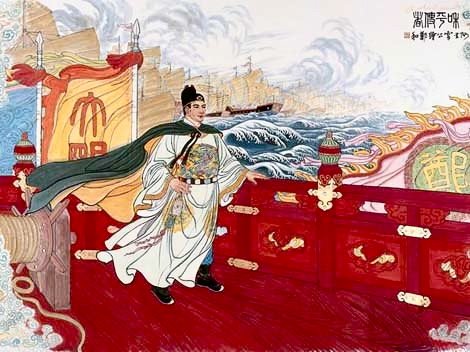 |
Why did Zheng He's Fleet need so many huge ships? One reason, of
course, was "Shock and Awe". The sight of these enormous ships
appearing on the horizon one by one must have been truly incredible for
the people all along the Indian Ocean's rim, and would have enhanced
Ming China's prestige immeasurably.
The other reason was that Zheng He traveled with an estimated
27,000-28,000 sailors, marines, translators, and other crew members.
Along with their horses, rice, drinking water and trade goods, that
number of people required a staggering amount of room aboard ship. In
addition, they had to make space for the emissaries, tribute goods, and
wild animals that went back to China.
All of the measurements in the remaining Ming Chinese records of the
Treasure Fleet are in a unit called Zhang, which is made up of ten Chi
or "Chinese Feet." The Emperor ordered the construction of an amazing 62
or 63 such ships for Zheng He's first voyage, in 1405. Extant records
show that another 48 were ordered in 1408, plus 41 more in 1419. |
|
Fleet Ship Measurements are Given in English Feet |
Baoshan or "Treasure Ships" were the largest ships in
the fleet and were likely between 440 and 538 feet long by 210
feet wide. These 4-decked Baoshan had an estimated displacement
of 20-30,000 tons, roughly 1/3 to 1/2 the displacement of modern
American aircraft carriers. Each had nine masts on its deck,
rigged with square sails that could be adjusted in series to
maximize efficiency in different wind conditions.
Machuan or "Horse Ships" were smaller eight-masted ships.
They were about 2/3 the size of the Baoshan (340 feet by 138
feet). As indicated by the name, the Machuan carried horses,
along with timber for repairs and tribute goods. Along with
dozens of Baoshan, each armada included hundreds of smaller
ships.
Liangchuan or "Grain Ships" seven-masted carried rice and
other food for the crew and soldiers in the fleet. Liangchuan
were about 257 feet by 115 feet in size.
Zuochuan or "Troop Ships" the next ships in descending
order of size were at 220 by 84 feet. Each transport ship had
six masts.
"Warships" or Zhanchuan the smallest, were five-masted,
each about 165 feet long. They were designed to be maneuverable
in battle. Though tiny compared with the Baochuan, the Zhanchuan
they were more than twice as long as Christopher Columbus's
flagship, the Santa Maria. |
|
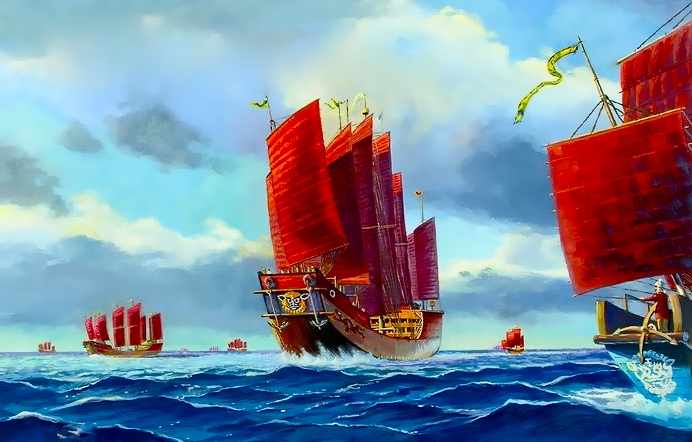 |
|
 |
 |
|
Ancient Chinese Votive Sword Found
in Georgia |
| In July 2014, an avocational surface collector chanced across a
partially exposed Chinese Votive Sword behind roots in an eroded bank of
a small stream in Georgia. The 30 cm artifact is possibly a one-of-a
kind find in North America and is another example in the growing list of
seemingly out-of-place Chinese artifacts suggesting Chinese travel to
North America in Pre-Columbian times. The exquisite sword has
preliminarily been identified as being fashioned in Lizardite and has
surface features indicating it is very old. It is hoped that future
testing will confirm the type of stone, and determine the source, since
Lizardite deposits exist in both eastern and western hemispheres. |
|
Chinese Votive Sword - Reverse Side |
| Less uncertain are the many symbols and the shape of the sword, both
of which are found on jade objects from the Xia (2070-1600 BC), Shang
(1600-1046 BC) and Zhou Dynasty (1046-256 BC). The dragon figure
spanning a portion of the top of the blade is typical to the Shang
Dynasty, as is the feathered crown. The grotesque face mask of the
Taotie on the guard and handle of the sword, first appears during the
Liangzhu culture (3400-2250 BC) but it is more commonly found during the
Shang and Zhou periods. (Siu-Leung Lee, PhD, personal conversation, and
soon to be published paper.) |
|
Left: Close-up of Dragon - Right:
Close-up of Taotie in this General Area |
| The dominant presence of Shang period diagnostics and the similarity
of the Taotie to depictions of the Mesoamerican Olmec Werejaguar,
provide clues as to when the sword was made and a general time frame for
when it may have arrived in Georgia. |
|
Chinese – Olmec Connection? |
The Similarity of Chinese-Olmec Mythology and Symbolism: Has
been the subject of scholarly debate for over one hundred years. It is
perhaps no coincidence that the Olmec culture appears around 1500 BC
during the beginning of the Shang Dynasty, and the first written history
of China begins. It was the start of the Bronze Age resulting in ornate
bronze works of art, bronze chariots and weaponry. The first Chinese
script appears at this time along with extensive irrigation systems and
other public works projects, all indicators of a sophisticated and
advanced culture.
It was also a time in Chinese culture when Jade was more valuable than
Gold, and likewise with the Olmec elite who had Jade deposits located in
what is now Honduras and Guatemala. It may not be coincidental the Olmec,
during their Middle Formative period (900-300 BC), mastered the
difficulties of shaping and drilling Jade (a stone so hard that it
cannot be worked with steel tools), with abrasive materials into small
ornamental and votive pieces. The similarities of Chinese-Olmec art is
quite telling.
The likely introduction of Chinese concepts of rulership and a
stratified society, along with their religion and symbolism no doubt
altered the Olmec and later Mesoamerican groups. It was an event that
would be repeated in the 16th century when Spanish Friars waded ashore
carrying the cross of Christianity. |
|
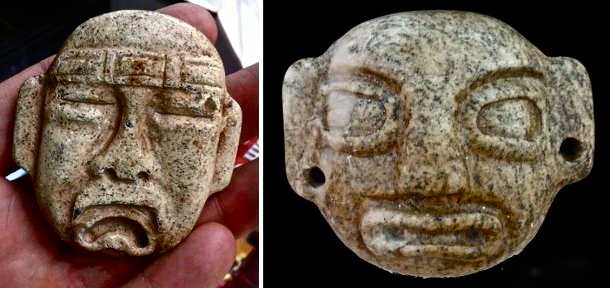 |
|
Olmec Style Pendants
Found in Creek near Chinese Votive Sword |
| About 90 years before Columbus first sailed into Caribbean
waters, the Ming Chinese dispatched flotillas under the command of
Admiral Zheng He on multiple voyages to the lands around the Indian
Ocean to acquire exotic items and materials. The Admiral's first
expedition consisted of approximately 185 vessels. You have to ask why
a person would tote around a Votive Sword which by definition is an
object “expressing a religious vow, wish, or desire: offered or
performed as an expression of thanks or devotion to God”, if they were
not Chinese. |
|
How did the Sword get to Georgia?. .
. some Possibilities |
Around 900 BC, these new Olmec cultural attributes started to spread
throughout the region. There is considerable evidence indicating that
they served as a foundation for other contemporaneous and subsequent
cultural groups, such as the Maya. Though modified by other groups to
meet local needs and with changes over time, the basic concepts of the
Olmecs persisted into the 16th century conquest period. Interestingly,
some of these ancient concepts, such as those relating to the planting
of maize, are still practiced today within certain Mesoamerican
indigenous groups. It is generally believed this dispersal was a
by-product of the Olmec land and coastal maritime trade routes
transporting basic and exotic trade goods.
An intriguing element to this cultural phenomenon, and why it is
mentioned, is that it starts around 900 BC, which as mentioned
previously, is when the Olmec started making Jade ceremonial objects.
An example that illustrates the geographic extent of this cultural
diffusion is the distribution of flat and cylindrical printing seals, a
technology that first appears in the Mesoamerica artifact record with
the Olmec. In China, printing seals first appear during the Shang
Dynasty. |
|
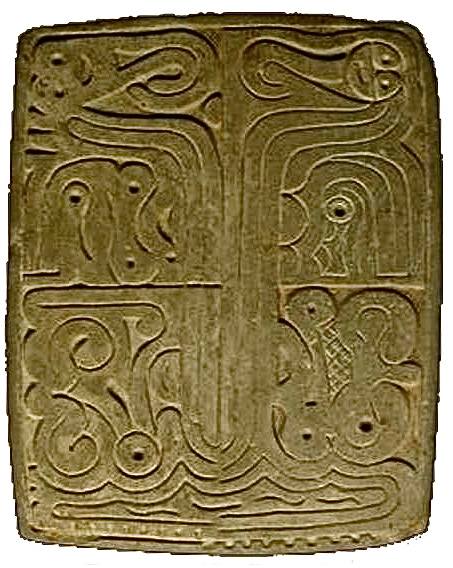 |
Olmec Traditions Spread North
By 800 BC, the seals were in use in northern South
America some 1700 miles south of the Olmec heartland, and an equal
distance to the north with the Adena Culture (800 BC-1 AD) in the upper
Ohio River Valley in North America. Not only did the printing technology
arrive in Ohio but also Olmec art.
In an unpublished research project on the Adena tablet (shown left),
stylistic duplicates of the unique center vertical element representing
the World Tree, at the Lake Chalco region south of now Mexico City and
at Veracruz on the Gulf coast.
The arrival of seals at the beginning of the transformational mound
building Adena culture, along with other evidence too numerous to
include in this short article, indicates that an influential
Mesoamerican group entered the region and influenced the cultural
destiny of the local population.
Also, one cannot overlook that the Olmec and Maya had a fleet of large
ocean going canoes plying the coastal waters of the Gulf region, and the
logistical organization to supply the basic needs of major urban areas
with population densities equal to today’s major cities. |
|
Seal From the Adena Culture |
Circum-Caribbean Region Cultures |
| For example, salt, a basic requirement for survival in the tropics,
needed in countless tons per month, was shipped from salt producing
facilities in the Yucatan to known river ports stretching from the
Honduran Moskito Coast to Tampico, Mexico. The various cultures
occupying the lands of now Georgia and other States fronting on the Gulf
of Mexico, along with the Caribbean Islands, Mexico, and South America,
were in a circum-Caribbean region where everyone knew their neighbors.
From all of this it is seems apparent that the circum-Caribbean
region cultures, even in more ancient times, were connected by water and
land routes, and this furnishes us a possible explanation as to how the
sword and two Olmec-style pendants arrived in Georgia. |
|
Did China 'Discover' America?
Ancient Chinese Script Carved into Rocks
Asiatics visited the 'New World' 3,300 years ago! |
| "Discovery of the Americas" has for centuries been credited
to the Italian explorer Christopher Columbus, but ancient markings
carved into rocks around the US could require history to be rewritten. |
|
Petroglyph National Monument - Near Albuquerque, New
Mexico |
|
Pictograms from the Chinese Shang
Dynasty - Etched into rocks in America
The symbols are carved into rocks in New Mexico, California and Arizona.
Indicates the Chinese were exploring North America long before
Europeans.
The symbols give details of journeys and honor the Shang King. |
|
Ancient Chinese Inscription Locations |
| Ancient scripts suggest Chinese explorers discovered America long
before Europeans arrived. They could have been inscribed alongside the
carvings of Native Americans by Chinese explorers thousands of years
ago. |
|
Chinese Explorers were Conducting Expeditions -
North America Thousands of Years Ago
Left these Markings as Evidence of their Presence? |
| These Petroglyphs indicate ancient people from Asia were present in
the Americas around 1,300 BC. Nearly 2,800 years before Columbus's ships
stumbled across the New World by reaching the Caribbean in 1492. |
|
Ancient Chinese Symbol for 'Returning Together'
Weathering on the markings suggest they are very old |
Oracle Bone Script - 'Together for Ten Years'
It was found alongside other markings on a rock in Arizona |
The Pictograms discovered on the rocks appear to be an ancient
script that was used by the Chinese after the end of the Shang Dynasty.
Examined by experts on ancient Chinese writing, they appear to be forms
that went out of use thousands of years ago.
Known as Oracle Bone Pictograms, the markings record a ritual
sacrificial offering perhaps made to the 3rd Shang Dynasty King, Da Jia,
and also a divination of an 'Auspicious' 10 day sacred period.The
carvings appear to have undergone significant levels of weathering,
known as repatination, which indicate they were created long ago. Based
on repatination, they appear to have antiquity to them. Shang Script
disappeared from use around the fall of the Shang Empire in 1046 BC and
were only rediscovered and deciphered in 1899 in China.
There is DNA evidence which has suggested Native Americans and Asian
populations share many genetic traits. For centuries, researchers have
been debating if, in pre-Columbian times, meaningful exchanges between
the indigenous peoples of Asia and the Americas might have taken place.
For instance, Dr Dennis Stanford of the Smithsonian Institution, who
believed North America was first populated by people from Asia during
the last ice age.
It now appears likely Asiatic explorers not only reached the Americas,
but they interacted positively with Native North American people, on
multiple occasions, long before any European exploration of the
continent. |
|
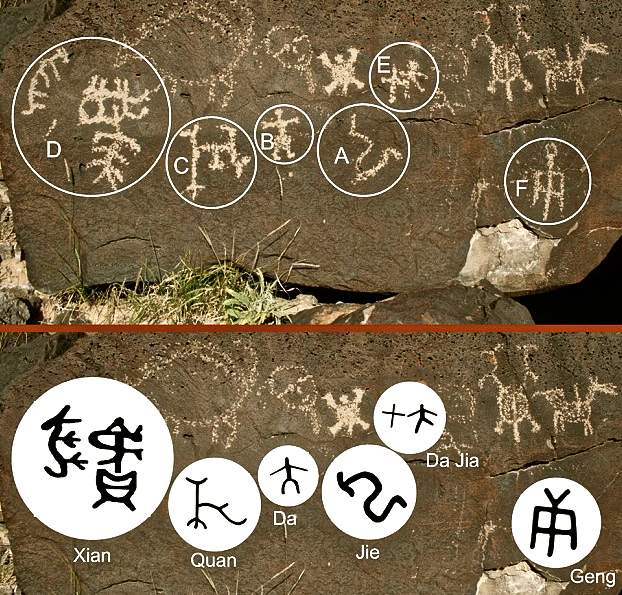 |
|
Etched into rock at the Petroglyph National
Monument in New Mexico |
When the four central pictogram-glyphs of this message - Jie, Da,
Quan, and Xian - are read in the traditional Chinese manner from right
to left we learn about a respectful man honoring a superior with the
sacrificial offering of a dog.
Notably, the written order of these symbols conforms with the syntax
used for documenting ancient Chinese rituals during the Shang and Zhou
Dynasties, and dog sacrifices were very popular in the second part of
the Second Millennium BC in China.' |
|
The First Dynasty of China
described in classic texts and historical documents was the Xia
Dynasty
Established in 2070 BC in the Yellow River Valley
However, the origins of Chinese Civilization itself may date
back 2,400 years earlier than assumed |
|
Researchers from the Institute of Geochemistry
Chinese Academy of Sciences have published a study detailing
their examination of the Neolithic environment in northeastern
China. Ancient tribes resided in these areas of lush
vegetation. Evidence of rapid shifts into arid desert conditions
6,500 years ago forced the early Hongshan tribe to spread into
unpopulated areas. They brought their culture and traditions
with them, and researchers are suggesting this played a
formative role in Chinese civilization. |
|
Map of the Middle Neolithic
Cultures in China - Including the Hongshan (#1) |
 |
The findings are controversial, as Chinese culture is seen
as beginning in the Yellow River valley, with the Hongshan and
other early tribes playing only a small influence, as they were
considered remote and disconnected. If findings on the Hongshan
movements and influence is accurate, Chinese civilization may be
thousands of years older than previously assumed, having evolved
in the north and spread toward the central region. The British
Museum describes the early Hongshan culture (4700 to 2900 BC) as
sophisticated, and lists the many intricate jade artifacts
discovered at “impressive ceremonial sites”, such as discs,
hoof-shaped objects, pendants, rings and hair ornaments. |
|
Hongshan platform at
Niuheliang (Left) and central burial with carved jades (Right) |
|
|
Pig Dragons and Embryo Dragon sculptures are
attributed to the Hongshan Culture. These are said to be the
first representations of the Chinese Dragon. The earliest
Chinese written character for “Dragon” is very similarly formed
to the Hongshan examples.
Pigs, Dragons, and Eagles featured in the
culture’s grave goods. Pig bones were buried with humans in
graves, and Hongshan artifacts are some of the earliest examples
of jade working. Fertility was a major theme in their work, with
fetus and pregnant women objects featuring repeatedly. |
In 1983 the Hongshan archaeological site Niuheliang was
discovered, and excavations revealed an underground temple
complex known as the Goddess Temple. Inside the Temple were
found three exceedingly large clay figurines, as large as three
times the size of real-life humans.
The Niuheliang Archaeological Site is an outstanding example of
“holy sacrificial land” of the early period of human
civilization so far discovered in Northeast Asia, and boasts the
largest scale, the highest rank, and the most prominent
expression of beliefs.The role of the Hongshan culture is
reexamined. We seem to see evidence that Hongshan was far more
important to early Chinese culture than it’s currently given
credit for. |
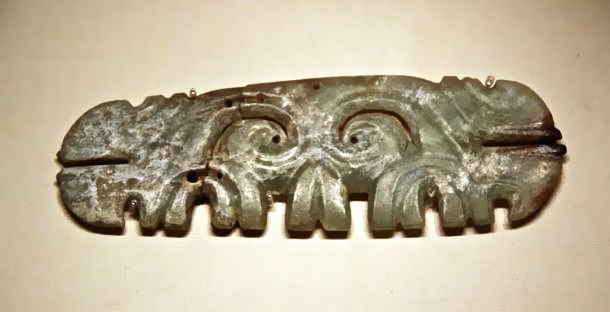 |
| |
Neolithic Jade Plaque -
Hongshan Culture |
In
order to discover more about Hongshan Culture, researchers
investigated the Hunshandake Sandy Lakes in Inner Mongolia, an
area 185 miles (300 kilometres) away from the first Hongshan
discoveries. The team found significant quantities of Hongshan
pottery and stone items in Hunshandake, indicating that Hongshan
culture had been much more widespread than previously thought.
These findings on the Neolithic environmental conditions may be
a step towards reconsidering the influence of early tribes on
China's historical development. |
|
Chinese Jade Dragon Design |
Chinese Neolithic Dog Design
Pottery |
|
Amid the once-tranquil village of Sanxingdui, in a
quiet part of Sichuan province in China, a remarkable discovery took
place which immediately attracted international attention and has since
rewritten the history of Chinese civilization. |
|
Two giant sacrificial pits were unearthed
containing thousands of gold, bronze, jade, ivory and pottery artifacts
that were so unusual and unlike anything ever found in China before that
archaeologists realized they had just opened the door to an ancient
culture dating back between 3,000 and 5,000 years. |
In the spring of 1929, a farmer was digging a well when he
discovered a large stash of jade relics. This was the first clue that
eventually led to the discovery of a mysterious ancient kingdom.
Generations of Chinese archaeologists searched the area without success
until 1986, when workers accidentally found the pits containing
thousands of artifacts that had been broken, burned, and then carefully
buried.
The discovery of the artifacts opened up a world of intrigue. The
objects found in the sacrificial pits included animal-faced sculptures
and masks with dragon ears, open mouths and grinning teeth; human-like
heads with gold foil masks; decorative animals including dragons,
snakes, and birds; a giant wand, a sacrificial altar, a 4-meter-tall
(13-foot-tall)bronze tree; axes, tablets, rings, knives, and hundreds
of other unique items. Among the collection was also the world’s largest
and best preserved bronze upright human figure, measuring 2.62 meters (8
feet). |
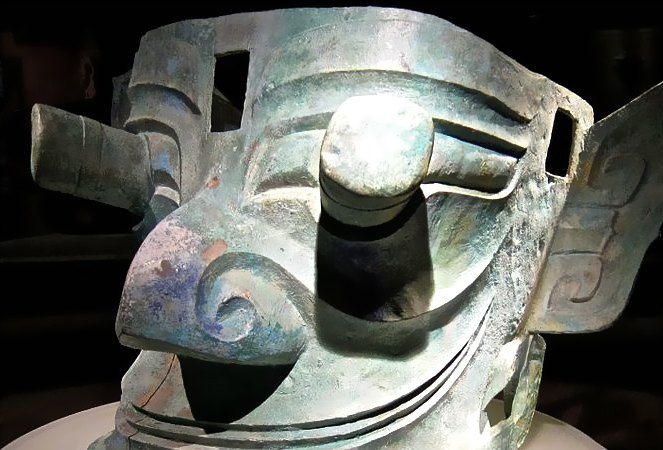 |
| However, by far the most striking findings were dozens
of large bronze masks and heads represented with angular human features. |
Large Bronze Head with Protruding Eyes - Believed
to Depict Cancong, the Semi-legendary First King of Shu. |
| These bronze masks and heads have exaggerated almond-shaped eyes,
straight noses, square faces, and huge ears, features which don’t
reflect those of Asian people. |
|
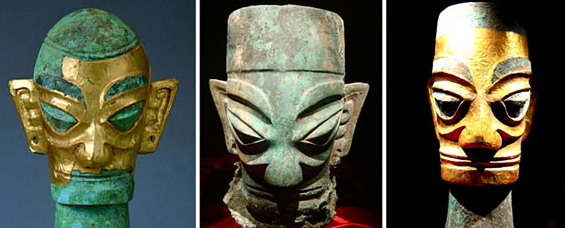 |
| Researchers were astonished to find an artistic style that was
completely unknown in the history of Chinese art, whose baseline had
been the history and artifacts of the Yellow River civilization(s).
Some of the masks were enormous in size – one measures an incredible
1.32 meters in width and 0.72 meters (2.36 feet) in height, the largest
bronze mask ever found. The three largest masks have the most
supernatural features of all the Sanxingdui artifacts, with animal-like
ears, monstrously protruding pupils, or an additional ornate trunk.
The artifacts were radiocarbon dated to the 12th-11th centuries BC. They
had been created using remarkably advanced bronze casting technology,
which was acquired by adding lead to a combination of copper and tin,
creating a stronger substance that could create substantially larger and
heavier objects, such as the life-size human statue and the 4-meter-tall
(13-foot-tall) tree.
The ancient artifacts found in the two pits date to the time of the
Shang dynasty, in the late second millennium BC, when the primary
civilized society was flourishing in the Yellow River valley, in north
China, thousands of miles from Sichuan. No similar find has been made
anywhere else, and there are no inscriptions at the Sanxingdui site to
shed light on its culture, which was apparently a distinctive Bronze Age
civilization, unrecorded in historical texts and previously unknown. The
discovery contributed to a fundamental shift from the traditional
understanding of a single centre of civilization in north China to the
recognition of the existence of multiple regional traditions, of which
Sichuan was clearly one of the most distinct. |
The culture that produced these artifacts is now known as the
Sanxingdui Culture, and archaeologists are identifying it with the
ancient kingdom of Shu, linking the artifacts found at the site to its
early legendary kings. References to a Shu kingdom that can be reliably
dated to such an early period in Chinese historical records are scant
(it is mentioned in Shiji and Shujing as an ally of the Zhou who
defeated the Shang), but accounts of the legendary kings of Shu may be
found in local annals.
According to the Chronicles of Huayang compiled in the Jin Dynasty
(265–420 AD), the Shu kingdom was founded by Cancong. Cancong was
described as having protruding eyes, a feature that is found in the
figures of Sanxingdui. Other rulers mentioned in Chronicles of Huayang
include Boguan, Yufu, and Duyu. Many of the objects are fish and
bird-shaped, and these have been suggested to be totems of Boguan and
Yufu (the name Yufu actually means fish cormorant).
A metropolis of its time, covering about three square kilometers (1.8
square miles), Sanxingdui had highly developed agriculture, including
winemaking ability, ceramic technology and sacrificial tools and mining
was commonplace. According to archaeological findings, the settlement at
Sanxingdui was abandoned suddenly around 1,000 BC. For reasons that are
still unknown, the prime of Sanxingdui Culture came to an abrupt end.
The sacrificial pits are believed to have been sites for the ancient Shu
people to offer sacrifice to Heaven, Earth, mountains, rivers, and other
natural gods. The human-like figures, bronze animal-faced masks with
protruding eyes and flat bronze animal-faced masks may be natural gods
worshiped by the Shu people.
“Judging from the numerous bronze human images and funerary objects, the
ancient Sanxingdui kingdom had unified and ruled the people through
primordial religion. They worshiped nature, totems and their ancestors.
The ancient Shu kingdom probably often held grand sacrificial activities
to attract tribes with different religious beliefs to come from far and
near to worship,” said Ao Tianzhao from the Sanxingdui Museum, who has
been studying the Sanxingdui culture for half a century. He believes the
large number of bronze artifacts at Sanxingdui indicates that this site
used to be a mecca for pilgrims.Since the discovery, these artifacts
have received a great amount of international interest and attention.
They have been exhibited at world renowned museums such as The British
Museum, Taipei’s National Palace Museum, National Gallery of Art
(Washington), Guggenheim Museum (New York), Asian Art Museum (San
Francisco), Art Gallery of New South Wales (Sydney) and Lausanne Olympic
Museum (Switzerland). A selection of the artifacts are now making their
way to the Bowers Museum in Santa Ana, California, where the exhibition,
‘China’s Lost Civilization: the Mystery of Sanxingdui’, will be featured
from 19th October 2014 to 15th March, 2015.
|
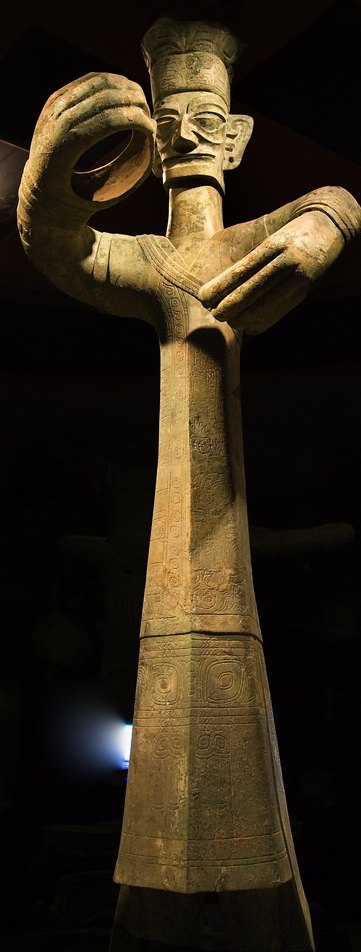 |
|
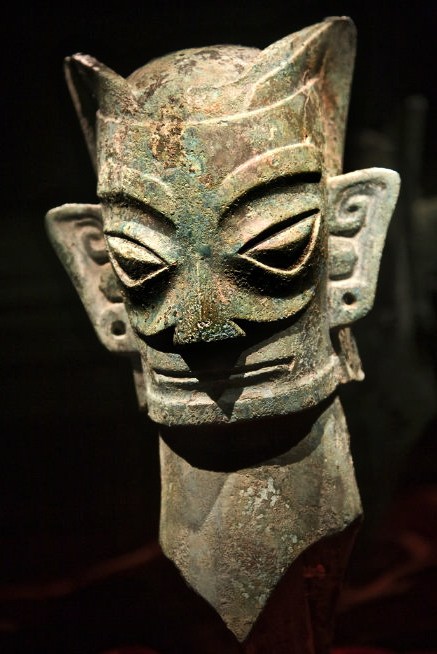 |
 |
| The discovery of Sanxingdui shocked the world, but the history of
the artifacts remains a mystery. Only the contents of two solitary pits
reflect the immemorial and brilliant civilization of the Shu – no other
artifacts like them have ever been found since. There are no historical
records, and no ancient texts that speak of them, leaving experts asking
what the purpose of the objects was, where the culture came from, and
where they went after burying their most precious treasures. The
Sanxingdui civilization is a unique page in China’s long history and for
now it remains an enigma. |
|
New Prayer Hall - Built by Donation from the King
of Oman |
|
Qingjing Mosque was built in 1009, following the
architectural style of mosques in Damascus of Syria.
Qingjing Mosque in Quanzhou, is the oldest mosque existing in China, and
is a historical witness of the cultural exchange between China and
Arabian countries.
Located in southeast China's Fujian Province, Quanzhou City used to be
the starting point of the ancient Maritime Silk Road and the biggest
port of the East in the Sung and Yuan Dynasties (960-1368).
During that period, sea trade between China and the West was flourishing
as never before. Many of the merchants were Muslims from Arabian
countries, who transported precious spices and crude drugs to China and
carried away Chinese silks and porcelains. |
|
A Muslim in Qingjing Mosque at Prayer |
Qingjing Mosque Courtyard |
|
Art Exhibition Highlights Ancient Chinese Essence |
Returning to Ancient Essence”, a Chinese painting and calligraphy
exhibition organized by the Albergue SCM for artist Deng Xian Yeng, is
showcasing about 70 pieces of art at the Exhibition Hall of the UNESCO
Centre of Macau, until next Tuesday.
“The biggest theme of my paintings is ‘clean’, meaning clear and in
contrast to feculent. The sense of line in calligraphy is demonstrated
incisively and vividly in my paintings, which complies with the soul and
spirit of Chinese painting,” explained Mr. Deng at the opening ceremony
last Wednesday.
“Chinese painting and calligraphy endure, but in a slow process. Today’s
Chinese painting can’t detach from its thousand-year tradition. We can
only extend and develop [the art-form] along the track of traditions,”
Mr Deng explained to the Times. “Those who are truly practicing Chinese
painting are actually abiding by the traditions, and exploring in order
to solve certain problems and deficiencies existing in the traditions.
Regardless of the field – landscape, characters or
flowers and birds – there are unsolved deficiencies of the art-form.
Therefore, the later generations have to study and develop it. This is a
painter’s ideal.” |
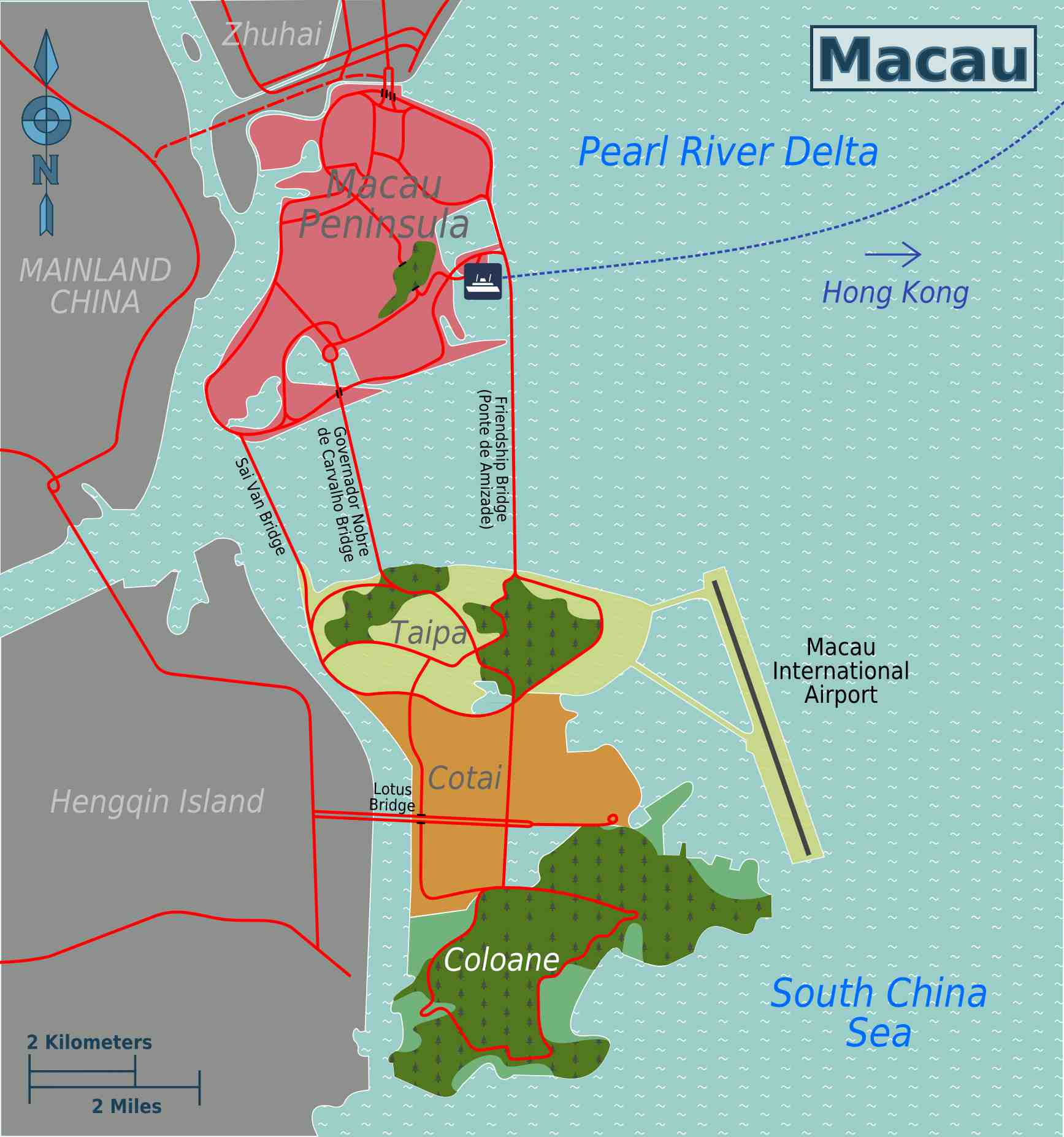 |
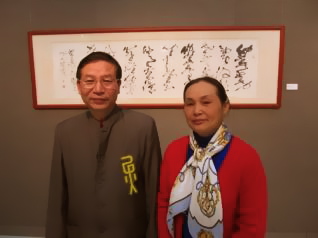 |
Deng Xian Yeng is the Vice President of the China
Research Institution of Painting and Calligraphy. He focuses on
exploring alternative ways of brush-handling to the traditional
techniques. “These techniques are not enough, as some things cannot be
expressed on paper. In fact, if a painter can solve just one problem in
his whole life, he has already got very good skills.”
Amongst the various subject matters of traditional Chinese painting,
water and mountains are Mr. Deng’s favorites, as they present a
“boundless world of panoramic views.” “It’s necessary to travel
thousands of miles and imitate ancient masterpieces,” he suggested.
Mr. Deng follows the style of various classic calligraphers and
painters such as Wang Xizhi, Dong Qichang and Shi Tao. |
| “I imitate their masterpieces because they are all epochal masters. Aim high or you may fall [into being] average;
that’s the same for painting and calligraphy. So you should learn from
the superb works. People are imitating and learning throughout their
whole lives; there is no end. “You can’t always be
wrapped up in tradition; but at the same time you can’t deviate from
tradition,” emphasized the experienced painter, suggesting that young
artists should value tradition more. “It’s dire that these days the
painters who practice Chinese painting lack calligraphic skills, because
Chinese calligraphy and painting share the same origin. A painter can’t
be skilled in their brushstrokes if they don’t know the brush-handling
skills in calligraphy, not to mention their inscription on a painting,”
he explained. Staff reporter |
|